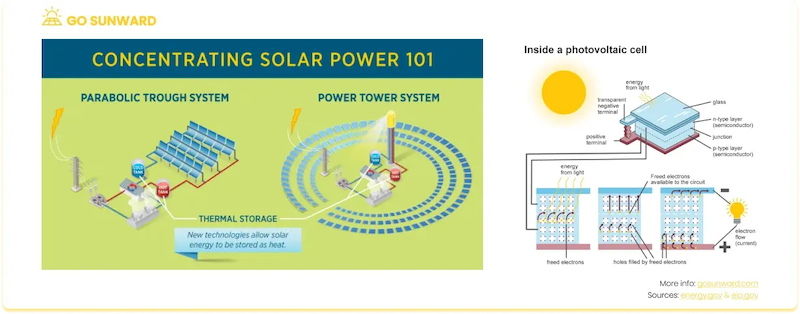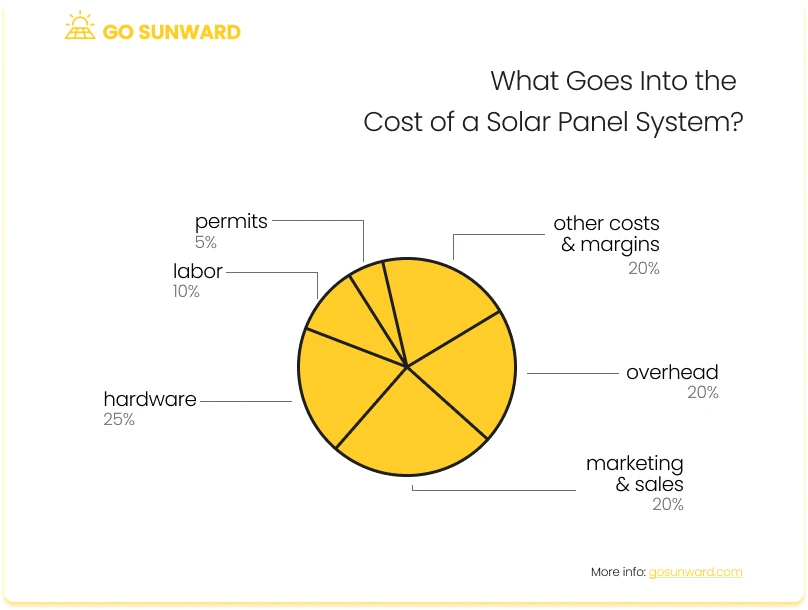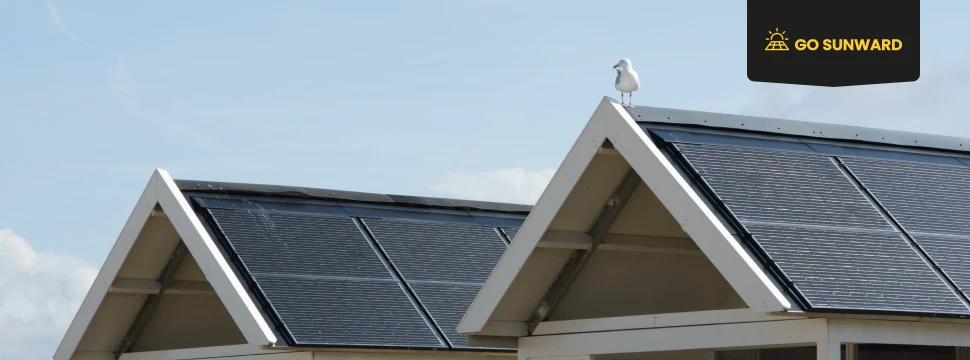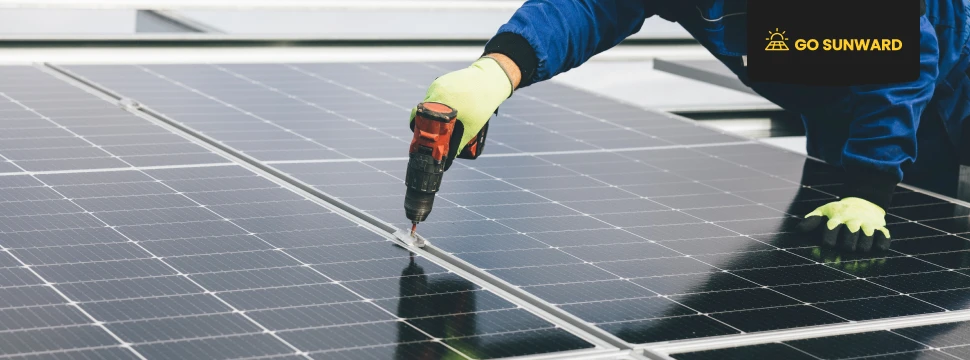Solar Power: How To Power Your House With The Sun ☀️
In today’s world, solar power has emerged as a feasible and increasingly popular solution to address the pressing issues of climate change and rising energy costs. With an increasing global awareness of environmental sustainability and a growing need for economical energy sources, solar energy has taken center stage as the renewable energy technology of choice.
Harnessing the sun’s power not only offers profound environmental benefits by reducing greenhouse gas emissions but also promises substantial cost savings for individuals and businesses alike.
This article aims to serve as a comprehensive guide for readers eager to embrace solar power as a means to meet their household energy needs. By exploring the various facets of solar energy adoption, from understanding its technology to practical implementation, installation and costs, we intend to empower readers to make informed choices that align with both their environmental and financial goals.
Understanding Solar Power: The Basics
Before looking at how we can use solar panels at home, it is first crucial to understand how solar power works, in terms of how solar radiation is harnessed for electricity generation and what technologies are used to enable this to happen.
Solar radiation, a form of electromagnetic energy emitted by the sun, illuminates the Earth. While sunlight reaches all parts of the planet, the amount of solar radiation that reaches a specific spot on the Earth’s surface varies. Solar technologies capture this radiation and convert it into practical energy sources. Solar energy has vast potential: the amount of solar radiation that reaches the Earth’s surface in just one hour exceeds the world’s total energy consumption for an entire year.
Solar technologies harness this sunlight in two main ways: through photovoltaic (PV) solar panels or by concentrating solar radiation using mirrors in concentrated solar power (CSP) technology. The collected energy can then be used to generate electricity or stored in batteries or thermal storage systems for future use.
So now we know that solar can energy, but…. How Much Energy Does A Solar Panel Produce?
Solar PV 101
Solar photovoltaics operate on the principle of the photovoltaic effect, a straightforward process in which photons, particles of light, strike a material, typically silicon, and energize its electrons. This energy release causes the electrons to break free from their atomic bonds. These liberated electrons, carrying a negative charge, migrate to the front surface of the solar cell, creating an electrical imbalance akin to the poles of a battery.
Conductive materials in the cell capture these electrons. When these conductors are connected to something like a battery, an electric current starts to flow through the circuit. This flow of current is termed direct current (DC) because the electrons move in a single direction. Subsequently, inverters transform this DC into alternating current (AC), which is the form of electrical energy most commonly utilized in homes and businesses. For a more detailed guide on solar inverters, click here.

Solar CSP 101
Unlike solar panels, solar CSP systems use mirrors or lenses to focus sunlight onto a receiver, where it’s converted into heat. This intense heat generates steam, which then drives a turbine connected to a generator, producing electricity.
CSP installations often incorporate specialized storage systems to store solar thermal energy. This allows them to generate electricity even when sunlight is scarce, providing a consistent and dependable power source. Solar CSP is primarily employed in large-scale utility plants and is most effective in regions with abundant sunlight.
There are two primary types of CSP systems:
- Parabolic Trough Systems: These systems utilize long curved mirrors (parabolic troughs) to concentrate sunlight onto a linear receiver tube positioned at the focal point of the trough. Inside the receiver tube, a heat transfer fluid absorbs the concentrated sunlight, leading to a temperature increase.
- Solar Power Tower Systems: In this setup, an array of mirrors is arranged to track the sun’s movement and reflect sunlight onto a central receiver tower. A heat-absorbing material is placed at the top of the tower, which heats up as it receives the concentrated sunlight.

Solar Panel Technology
At present, photovoltaics is one of the most recognizable methods for capturing solar energy in the US and is the most common way of turning solar radiation into usable electricity. Solar PV utilizes three technology panel types: Monocrystalline, Polycrystalline and Thin-Film Solar Panels.
Each of these options comes with its own set of pros and cons. Selecting the most appropriate solar panel type for your solar installers to use, and deciding on specific brands hinges on your preferences and the unique features of your property. For more information on what types of solar panels are available in the market, click here.

Option 1: Monocrystalline Solar Panels
Monocrystalline solar panels are highly efficient due to their single-crystal silicon structure. They’re created by slicing cylindrical silicon ingots into thin wafers, providing a foundation for individual PV cells. This high purity results in excellent sunlight-to-electricity conversion rates. They have a distinct dark appearance with rounded edges. Their efficiency allows them to generate more power in less space, making them suitable for small installation areas. However, they can be pricier due to their manufacturing process.
Option 2: Polycrystalline Solar Panels
Polycrystalline solar panels have multiple silicon crystal structures, giving them a bluish tint. They are cost-effective to produce by melting raw silicon and forming square wafers. While slightly less efficient than monocrystalline panels, ongoing technological improvements have reduced this gap. Polycrystalline panels offer good performance and are popular in residential and commercial installations due to their affordability and durability.
Option 3: Thin-Film Solar Panels
Thin-film solar panels use thin layers of semiconductor materials like amorphous silicon, cadmium telluride, or copper indium gallium selenide (CIGS). These panels are lightweight, flexible, and adaptable, making them suitable for curved or irregular surfaces. Although they have lower efficiency compared to monocrystalline and polycrystalline panels, thin-film panels shine in low-light conditions and withstand high temperatures. Due to their ease of integration, they are ideal for applications like building-integrated photovoltaics (BIPV), solar shingles, and innovative solar designs.
In addition to thin-film, polycrystalline, and monocrystalline solar panels, there are several other panel options, each with unique characteristics and applications. These include panels like bifacial, organic photovoltaic (OPV) and building-integrated photovoltaics (BIPV).

Residential Solar: Is It For You?
Rooftop solar panels are commonly installed on residential properties, capturing sunlight and converting it into electricity through photovoltaic cells. This energy can power the home’s appliances, lighting, and other electrical needs.
In addition to generating electricity, some solar panels are designed to provide solar heating. They can be integrated into a home’s hot water system, reducing the need for conventional water heating methods and further lowering energy bills. Battery storage systems are also increasingly integrated with residential solar setups, enabling energy storage for use during non-sunny hours, thus boosting the feasibility of solar power even more.
There are numerous benefits to using residential solar:
Cost Savings: Residential solar power significantly reduces electricity bills, allowing homeowners to save money over time. Excess energy production can even lead to potential earnings through net metering or feed-in tariffs.
Environmental Benefits: Solar panels contribute to a cleaner environment by lowering carbon emissions. They rely on a renewable energy source, the sun, reducing the reliance on fossil fuels and mitigating the greenhouse effect.
Energy Independence: Solar power grants greater energy independence. Homeowners rely less on traditional utility companies and have more control over their electricity generation and consumption. This independence provides security against rising energy costs and grid failures.
Increased Property Value: Solar panel installations can increase the resale value of a property. Potential buyers often view solar panels as an attractive feature due to the long-term cost savings they offer. This can make your property more appealing in the real estate market.
Sizing Your Solar Power System
While residential solar offers numerous benefits for the homeowner, it is important for consumers to assess their home’s solar potential first, to ensure that the solar system is tailored to your property’s unique conditions, maximizing energy production, cost savings, and environmental benefits.
Conducting a comprehensive solar site assessment is a critical step. This assessment, typically performed by a professional solar installer, evaluates your property’s specific conditions and calculates its solar potential accurately. It considers factors such as local climate, shading, available roof space, and the angle of your roof.
Solar Panel Calculators
Another crucial aspect of your journey to powering your home with solar is working out your domestic electricity needs and deciding how many solar panels you need for your home.
To do this, you need to first gather some crucial information:
- Your average energy consumption: To calculate your average energy requirements, find your household’s electricity consumption data on your utility bills, typically measured in kilowatt-hours (kWh) monthly or annually. If daily data is missing, divide the monthly average by 30 or the annual average by 365 to get the daily average. Then, divide the daily average by 24 to determine your hourly electricity consumption.
- Your current energy usage in watts: Watts measure how much energy a device uses at one moment, while Kilowatt-hours (kWh) measure total energy use over time. You need to convert your hourly energy consumption into watts by multiplying it by 1,000.
- The local climate and sunlight availability: The amount of sunlight affects your solar panel energy. Most U.S. roofs get about 4 ‘full’ hours of sunlight daily, but this varies by location. Find out yours and then divide your average hourly wattage requirement by your area’s daily peak sunlight hours. This calculation reveals the hourly energy production target for your panels.
- The efficiency rating of the solar panels you’re thinking of using: Efficiency refers to the ability of a solar panel to convert sunlight into electricity. It is expressed as a percentage and represents the portion of sunlight energy that the panel can capture and convert into electrical power.
- The physical dimensions of the solar panels you’re considering: For small or oddly-shaped roofs, panel size and quantity matter. More space? Go for bigger, cost-effective panels. Limited space or shade? Opt for smaller, high-efficiency ones.
Once you have gathered this information, you are well on your way to calculating how many solar panels you will roughly need to power your home. This will also enable you to go on and estimate costs and the financial feasibility for your household. If you want to understand things in even more detail, then read our guide on understanding how do solar panels work (from sunlight to energy explained).
Final Calculation
You can calculate how many solar panels you need by multiplying your household’s hourly energy requirement (in watts) by the peak sunlight hours for your area and dividing that by a panel’s wattage. In other words:
Number of Panels = (Hourly Energy Requirement in watts x Peak Sunlight Hours) / Solar Panel Wattage
Companies often consider a 20% buffer when planning a solar installation to take into consideration system inefficiencies. For more detailed calculation, find one of the best solar companies to do the calculation for you.
Meeting All Your Home Electricity Needs With Solar Power
When embarking on residential solar power, a frequently asked question is, can solar fully power a house? And the simple answer is ‘yes’. Solar energy can absolutely power an entire household, and many have achieved complete energy independence with extensive solar systems. These homes aim for ‘net-zero’ energy, producing as much energy as they consume, effectively eliminating their carbon footprint.
However, some homeowners choose to remain connected to the local energy grid as a backup during cloudy or inclement weather. In some areas, utility companies may charge a small fee for this grid connection.
In certain regions, surplus energy from your solar panels can be returned to the grid, earning you credits. These credits can be used to access free electricity from the grid during nighttime or cloudy periods, a process known as net metering.

Solar Power Cost Considerations
Setting up a home solar power system is a substantial initial expense, yet the eventual advantages and cost reductions can justify the endeavor. Installation expenses depend on factors like system size, permits, hardware, labor, and financing.

Overall, the cost of a solar panel system can vary from a few thousand dollars for a small residential system to tens of thousands of dollars for a larger, high-efficiency system with energy storage. In the United States, our research shows that a typical residential solar panel installation might cost between $15,000 to $25,000 before incentives and rebates.
However, this cost can be significantly lower with incentives and can vary based on regional factors and individual circumstances. In the US, there are several government incentives for rooftop solar power that aim to encourage the adoption of solar energy by making it more affordable.
Some key incentives include:
Federal Investment Tax Credit (ITC): The ITC allows homeowners and businesses to deduct a percentage of their solar installation costs from their federal income taxes.
State and Local Incentives: Many states offer additional incentives, such as rebates, tax credits, or performance-based incentives, to promote solar adoption. These incentives vary widely by state and can significantly reduce the overall cost of a solar installation.
Net Metering: Net metering policies allow solar system owners to earn credits for excess electricity they generate and feed back into the grid. These credits can offset their future electricity bills, making solar power even more economically attractive.
Solar Renewable Energy Credits (SRECs): In some states, SRECs are tradable certificates that solar system owners can sell when they generate a certain amount of solar electricity. This provides an additional source of income for solar panel owners.
Property Tax Exemptions: Some states offer property tax exemptions or reductions for homes or businesses with solar installations, helping lower the overall solar ownership cost.Grant Programs: Certain regions may offer grants or financial incentives for solar projects, especially for nonprofit organizations, schools, or community solar installations.
Installing A Solar Installing A Solar Power SystemPower System
Installing enough solar panels to power a house is not quick; it requires careful planning and execution. Installation timing hinges on factors like house size, electricity requirements, solar panel efficiency, and installation complexity.
The installation process typically involves several stages, as outlined below. The duration of each stage can vary based on factors such as local regulations and availability of equipment and personnel. On average, the entire process may take anywhere from a few weeks to a few months.
1. Site Assessment (1-2 weeks): This stage involves evaluating the site’s suitability for solar panel installation. Factors like roof orientation, shading, and structural integrity are assessed. A solar professional will typically visit the site and gather data to design an optimal system.
2. System Design (1-3 weeks): Based on the site assessment, a solar professional will design a system tailored to meet the house’s electricity needs. This stage includes determining the number of panels required, their placement, and the electrical wiring layout.
3. Permit Acquisition (2-8 weeks): Obtaining the necessary permits from local authorities can take varying amounts of time depending on the region. This stage involves submitting design plans, engineering reports, and other required
4. Equipment Procurement (2-6 weeks): Once the system design is finalized, the solar installer will need to order the necessary equipment, including solar panels, inverters, mounting hardware, and wiring. The procurement process can take several weeks, depending on equipment availability and shipping times.
5. Installation (1-2 weeks): The actual installation of the solar panels typically takes one to two weeks, although it can vary based on system size and complexity. During this phase, the solar panels are mounted on the roof or ground, and electrical connections are made.
6. Inspection and Approval (1-4 weeks): After the installation is complete, local building inspectors or utility representatives may need to inspect the system to ensure it meets safety and code requirements. The timeframes for inspection and approval can vary, and it may take one to four weeks or longer.
7. Grid Connection (1-2 weeks): If your solar system is connected to the grid, the utility company will need to finalize the grid connection process. This typically involves installing a bi-directional meter that can measure both energy consumption and energy production. The utility may need one to two weeks or more to complete this step.
8. System Commissioning (1-2 days): Once all approvals and connections are in place, the solar installer will commission the system. This involves testing the system to ensure it is functioning correctly and efficiently.
9. Monitoring and Maintenance (Ongoing): After the installation is complete, ongoing monitoring and maintenance are essential to ensure the system continues to operate optimally. Regular maintenance may include cleaning the panels, checking for any issues, and adjusting as needed.
Panel Lifespan
Both polycrystalline and monocrystalline solar panels are designed to last beyond 25 years. Although there’s debate over whether monocrystalline panels exhibit a slightly lower degradation rate, the specific type of silicon solar cell in your panels generally doesn’t significantly impact their overall durability.
It’s essential to grasp that solar panels function by converting sunlight into electricity, a process that gradually leads to a decrease in power output at a rate of approximately 0.8% per year. As a result, you can expect your panels to maintain about 99.2% of their original output in the second year, 98.4% in the third year, and so forth. This gradual decline in performance is a normal aspect of a solar panel’s lifespan.
Moreover, solar panel warranties provide valuable information about the expected longevity of your solar panels and related components, such as inverters. It’s wise to carefully review these warranties as they can provide extra assurance regarding your solar energy system’s long-term performance and robustness.
How Many Solar Panels Do I Need For 1000 kWh Per Month? The answer might surprise you!
Conclusion
In conclusion, solar power emerges as a compelling solution for those in pursuit of cleaner and more sustainable energy alternatives. Its advantages extend beyond just cost savings and encompass significant environmental benefits by diminishing your carbon footprint. Moreover, with government incentives supporting solar adoption, the allure of energy independence becomes more attainable for homeowners.
As you embark on your solar journey, understanding the technology, incentives, and installation process equips you with the confidence to make a meaningful switch. Whether your motivation is rooted in environmental stewardship, financial prudence, or the aspiration for energy self-sufficiency, solar energy proves to be a pragmatic choice that aligns with your values.




